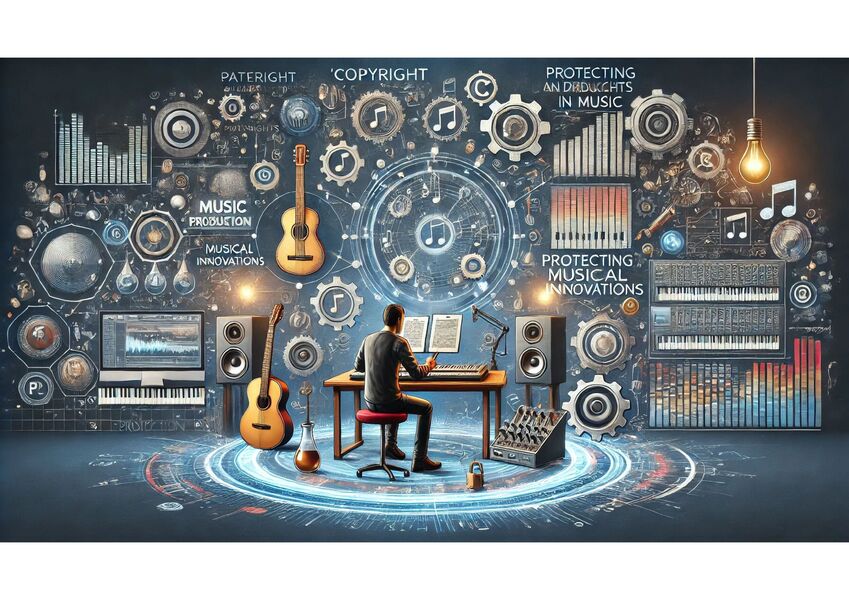Music patents and protection of innovations: Legal aspects of the protection of musical inventions and innovations

In today’s fast-paced and increasingly digital music industry, it is more important than ever for musicians and producers to protect their creative works and technical innovations. Patents and copyrights play a crucial role in ensuring that artistic and technical achievements are not unlawfully copied or exploited. This article will explain the legal options available for protecting musical innovations and the steps necessary to safeguard these creations.
1. The Difference Between Copyright and Patents in Music
Musicians are often familiar with copyright, which protects the creative expression of a musical work. Copyright is automatically granted once an original work is created and fixed in a tangible form—whether through recordings or written notation. This means that a song’s melody, lyrics, and composition are protected by copyright.
Patents, on the other hand, are less commonly known in the music field but are vital when it comes to protecting technical inventions used in music production. A patent protects new inventions or technical processes that can be applied in music, such as innovative musical instruments, software for music production, or new effects and sound generators. While copyright covers the creative expression of a work, a patent protects the technical innovation behind it.
2. What Can Be Patented in Music?
While a song or composition itself cannot be patented, there are many inventions in the music industry that can be patented. Here are a few examples:
- Musical Instruments: New types of musical instruments or mechanical improvements to existing instruments can be patented. For example, an innovative guitar design or a newly developed synthesizer model could be protected by a patent.
- Music Software: Software for music production or innovative digital tools that enable new ways of sound processing or composition are often patentable.
- Music Technologies: Inventions in audio technology, such as new microphones, speakers, amplifiers, or even innovative mixing and mastering tools, can also be protected by a patent.
Musicians should note that to be patentable, an invention must be new, inventive, and industrially applicable. A patent gives the inventor exclusive rights to commercially exploit the invention and prevent others from using it without permission.
3. The Path to a Music Patent: Step by Step
Research and Patentability Check:
Before applying for a patent, musicians should conduct thorough research to ensure that their invention is truly new. This means there must not be a similar invention already on the market. Patent searches can be conducted online through patent databases or with the help of a patent attorney.
Filing the Patent Application:
Once it has been confirmed that the innovation is new and patentable, the next step is to file a patent application. The application is submitted to a national patent office (e.g., the German Patent and Trademark Office, DPMA) or international authorities like the European Patent Office (EPO). The invention must be described in detail to demonstrate its novelty and inventive step.
Patent Examination:
After the application is submitted, the patent office will examine the innovation to determine if it meets legal requirements. This examination process can take several months or even years, depending on the complexity of the invention and the workload of the patent offices.
Issuance and Protection of the Patent:
Once the invention has passed the examination, the patent is granted, offering protection for up to 20 years. During this time, the inventor has exclusive rights to the invention, and may license it to others.
4. Why Protecting Innovations in Music Is Important
There is always a degree of competition in the music industry, and innovative technologies can offer a significant advantage. Without legal protection through patents or copyrights, musicians and inventors risk their innovations being copied or used without their consent. Losing exclusive rights can reduce the financial viability of a new instrument or software.
In addition to the financial benefits, patents offer the ability to license the invention. Musicians or inventors can license their inventions to other musicians, producers, or companies, creating an additional income stream. This is especially important because streaming revenue alone often isn’t sufficient for many artists.
5. Combining Copyright and Patent Protection
It’s important to understand that patents and copyrights often complement each other. While copyright protects the creative expression of a musical work, a patent covers the technical innovation. Musicians who create both musical works and technical innovations should consider how they can use both protection mechanisms to fully secure their rights.
6. Conclusion: Protecting Musical Innovations Is Essential
Protecting inventions and innovations in the music industry is not just relevant for large companies but also for independent musicians and producers. Patents and copyrights are effective tools for safeguarding creative and technical achievements, ensuring that artists maintain full control over their work and how it is used.
Musicians who develop innovative technologies or are engaged in music production should not overlook the legal protection of their inventions. A well-thought-out patent can make the difference between a successful innovation and losing rights and revenue. It is worth investing time and effort in protecting your work—for a sustainable and successful music career.
Search News
Recent Posts
- Fair Streaming in the Spotlights – Sound & Recording covers songs.de
- THIS IS ME – Your Music. Your Worth. Your Way.
- It's official: The songs.de app is now available in the app stores for IOS and ANDROID!
- C. van Ohr – A bold example of how to stream music fairly with songs.de
- New Feature for Labels on songs.de: Manage Artists and Catalogs Fairly and Directly



